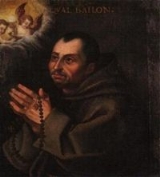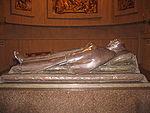
Paschal Baylon
Encyclopedia
Saint Paschal Baylon (24 May 1540 – 17 May 1592) was a Spanish
friar
and is a saint
in the Roman Catholic Church
. He is the patron saint of Eucharistic congresses and Eucharistic associations.
, in the Kingdom of Aragon
, on 24 May 1540, on the Feast of Pentecost
, called in Spain "the Pasch (or "Passover") of the Holy Ghost", hence the name Paschal. His parents, Martin Baylon and Elizabeth Jubera, were poor peasants. He spent his youth as a shepherd
. He would carry a book with him and beg passersby to teach him the alphabet and to read, and as he toiled in the fields he would read religious books.
In around 1564, he joined the Reformed Franciscan
Order (Alcantarine Reform) as a lay brother
. He chose to live in poor monasteries
because, he said, "I was born poor and am resolved to die in poverty and penance." He lived a life of poverty and prayer, even praying while working, for the rest of his life.
He was a mystic
and contemplative, and he had frequent ecstatic visions. He would spend the night before the altar in prayer many nights. At the same time, he sought to downplay any glory that might come from this piety. He died on May 17, which is his current feast day, in 1592.
 His tomb in the Royal Chapel in Villareal in the old province of Valencia, where he died, immediately became an object of pilgrimage
His tomb in the Royal Chapel in Villareal in the old province of Valencia, where he died, immediately became an object of pilgrimage
. Beatified by Paul V
in 1618, he was canonized by Alexander VIII
on October 16, 1690. The saint is usually depicted in adoration before a vision of the Eucharist
.
Forty years before he was canonized, an indigenous
Guatemala
n claimed to have had a vision of a sainted Paschal Baylon, appearing as a robed skeleton. This event became the basis of the heterodox tradition of San Pascualito
.
Paschal Baylon was enlisted in the Church's struggle against Modernism
, part of which was through increasing devotion towards the Sacrament of the Eucharist
; Pope Leo XIII
proclaimed Saint Paschal Baylon, the "seraph of the Eucharist", Patron of eucharistic congresses and all contemporary and future eucharistic associations. Christian Art usually depicts him wearing the Franciscan
habit and bearing a Monstrance
, signifying his devotion to the Holy Eucharist.
During the Red Terror
at the time of the Spanish Civil War
his grave was desecrated and his relics burned by anticlerical leftists.
Spanish people
The Spanish are citizens of the Kingdom of Spain. Within Spain, there are also a number of vigorous nationalisms and regionalisms, reflecting the country's complex history....
friar
Friar
A friar is a member of one of the mendicant orders.-Friars and monks:...
and is a saint
Saint
A saint is a holy person. In various religions, saints are people who are believed to have exceptional holiness.In Christian usage, "saint" refers to any believer who is "in Christ", and in whom Christ dwells, whether in heaven or in earth...
in the Roman Catholic Church
Roman Catholic Church
The Catholic Church, also known as the Roman Catholic Church, is the world's largest Christian church, with over a billion members. Led by the Pope, it defines its mission as spreading the gospel of Jesus Christ, administering the sacraments and exercising charity...
. He is the patron saint of Eucharistic congresses and Eucharistic associations.
Life
He was born at TorrehermosaTorrehermosa
Torrehermosa is a municipality located in the province of Zaragoza, Aragon, Spain. According to the 2004 census , the municipality has a population of 102 inhabitants. It was the birthplace of St. Paschal Baylon....
, in the Kingdom of Aragon
Kingdom of Aragon
The Kingdom of Aragon was a medieval and early modern kingdom in the Iberian Peninsula, corresponding to the modern-day autonomous community of Aragon, in Spain...
, on 24 May 1540, on the Feast of Pentecost
Pentecost
Pentecost is a prominent feast in the calendar of Ancient Israel celebrating the giving of the Law on Sinai, and also later in the Christian liturgical year commemorating the descent of the Holy Spirit upon the disciples of Christ after the Resurrection of Jesus...
, called in Spain "the Pasch (or "Passover") of the Holy Ghost", hence the name Paschal. His parents, Martin Baylon and Elizabeth Jubera, were poor peasants. He spent his youth as a shepherd
Shepherd
A shepherd is a person who tends, feeds or guards flocks of sheep.- Origins :Shepherding is one of the oldest occupations, beginning some 6,000 years ago in Asia Minor. Sheep were kept for their milk, meat and especially their wool...
. He would carry a book with him and beg passersby to teach him the alphabet and to read, and as he toiled in the fields he would read religious books.
In around 1564, he joined the Reformed Franciscan
Franciscan
Most Franciscans are members of Roman Catholic religious orders founded by Saint Francis of Assisi. Besides Roman Catholic communities, there are also Old Catholic, Anglican, Lutheran, ecumenical and Non-denominational Franciscan communities....
Order (Alcantarine Reform) as a lay brother
Lay brother
In the most common usage, lay brothers are those members of Catholic religious orders, particularly of monastic orders, occupied primarily with manual labour and with the secular affairs of a monastery or friary, in contrast to the choir monks of the same monastery who are devoted mainly to the...
. He chose to live in poor monasteries
Monastery
Monastery denotes the building, or complex of buildings, that houses a room reserved for prayer as well as the domestic quarters and workplace of monastics, whether monks or nuns, and whether living in community or alone .Monasteries may vary greatly in size – a small dwelling accommodating only...
because, he said, "I was born poor and am resolved to die in poverty and penance." He lived a life of poverty and prayer, even praying while working, for the rest of his life.
He was a mystic
Mysticism
Mysticism is the knowledge of, and especially the personal experience of, states of consciousness, i.e. levels of being, beyond normal human perception, including experience and even communion with a supreme being.-Classical origins:...
and contemplative, and he had frequent ecstatic visions. He would spend the night before the altar in prayer many nights. At the same time, he sought to downplay any glory that might come from this piety. He died on May 17, which is his current feast day, in 1592.
Veneration

Pilgrimage
A pilgrimage is a journey or search of great moral or spiritual significance. Typically, it is a journey to a shrine or other location of importance to a person's beliefs and faith...
. Beatified by Paul V
Pope Paul V
-Theology:Paul met with Galileo Galilei in 1616 after Cardinal Bellarmine had, on his orders, warned Galileo not to hold or defend the heliocentric ideas of Copernicus. Whether there was also an order not to teach those ideas in any way has been a matter for controversy...
in 1618, he was canonized by Alexander VIII
Pope Alexander VIII
Pope Alexander VIII , born Pietro Vito Ottoboni, was Pope from 1689 to 1691.-Early life:Pietro Ottoboni was born of a noble Venetian family, and was the son of Marco Ottoboni, chancellor of the Republic of Venice...
on October 16, 1690. The saint is usually depicted in adoration before a vision of the Eucharist
Eucharist
The Eucharist , also called Holy Communion, the Sacrament of the Altar, the Blessed Sacrament, the Lord's Supper, and other names, is a Christian sacrament or ordinance...
.
Forty years before he was canonized, an indigenous
Maya peoples
The Maya people constitute a diverse range of the Native American people of southern Mexico and northern Central America. The overarching term "Maya" is a collective designation to include the peoples of the region who share some degree of cultural and linguistic heritage; however, the term...
Guatemala
Guatemala
Guatemala is a country in Central America bordered by Mexico to the north and west, the Pacific Ocean to the southwest, Belize to the northeast, the Caribbean to the east, and Honduras and El Salvador to the southeast...
n claimed to have had a vision of a sainted Paschal Baylon, appearing as a robed skeleton. This event became the basis of the heterodox tradition of San Pascualito
San Pascualito
San Pascualito is a folk saint associated with Saint Paschal Baylon and venerated in Guatemala and the Mexican state of Chiapas. He is called "King of the Graveyard." His veneration is associated with the curing of disease, and is related to the Latin American cult of death...
.
Paschal Baylon was enlisted in the Church's struggle against Modernism
Modernism (Roman Catholicism)
Modernism refers to theological opinions expressed during the late 19th and early 20th centuries, but with influence reaching into the 21st century, which are characterized by a break with the past. Catholic modernists form an amorphous group. The term "modernist" appears in Pope Pius X's 1907...
, part of which was through increasing devotion towards the Sacrament of the Eucharist
Eucharist
The Eucharist , also called Holy Communion, the Sacrament of the Altar, the Blessed Sacrament, the Lord's Supper, and other names, is a Christian sacrament or ordinance...
; Pope Leo XIII
Pope Leo XIII
Pope Leo XIII , born Vincenzo Gioacchino Raffaele Luigi Pecci to an Italian comital family, was the 256th Pope of the Roman Catholic Church, reigning from 1878 to 1903...
proclaimed Saint Paschal Baylon, the "seraph of the Eucharist", Patron of eucharistic congresses and all contemporary and future eucharistic associations. Christian Art usually depicts him wearing the Franciscan
Franciscan
Most Franciscans are members of Roman Catholic religious orders founded by Saint Francis of Assisi. Besides Roman Catholic communities, there are also Old Catholic, Anglican, Lutheran, ecumenical and Non-denominational Franciscan communities....
habit and bearing a Monstrance
Monstrance
A monstrance is the vessel used in the Roman Catholic, Old Catholic, and Anglican churches to display the consecrated Eucharistic host, during Eucharistic adoration or Benediction of the Blessed Sacrament. Created in the medieval period for the public display of relics, the monstrance today is...
, signifying his devotion to the Holy Eucharist.
During the Red Terror
Red Terror (Spain)
The Red Terror in Spain is the name given by historians to various acts committed "by sections of nearly all the leftist groups" such as the killing of tens of thousands of people , as well as attacks on landowners, industrialists, and politicians, and the...
at the time of the Spanish Civil War
Spanish Civil War
The Spanish Civil WarAlso known as The Crusade among Nationalists, the Fourth Carlist War among Carlists, and The Rebellion or Uprising among Republicans. was a major conflict fought in Spain from 17 July 1936 to 1 April 1939...
his grave was desecrated and his relics burned by anticlerical leftists.
See also
- San PascualitoSan PascualitoSan Pascualito is a folk saint associated with Saint Paschal Baylon and venerated in Guatemala and the Mexican state of Chiapas. He is called "King of the Graveyard." His veneration is associated with the curing of disease, and is related to the Latin American cult of death...
- Three Fertility Saints of Obando, Bulacan, PhilippinesObando Fertility RitesThe Obando Fertility Rites is a Filipino dance ritual. Every year during the month of May, to the tune of musical instruments made out of bamboo materials, the men, women and children of Obando, Bulacan, Philippines wear traditional dance costumes to dance on the streets followed by the images of...

